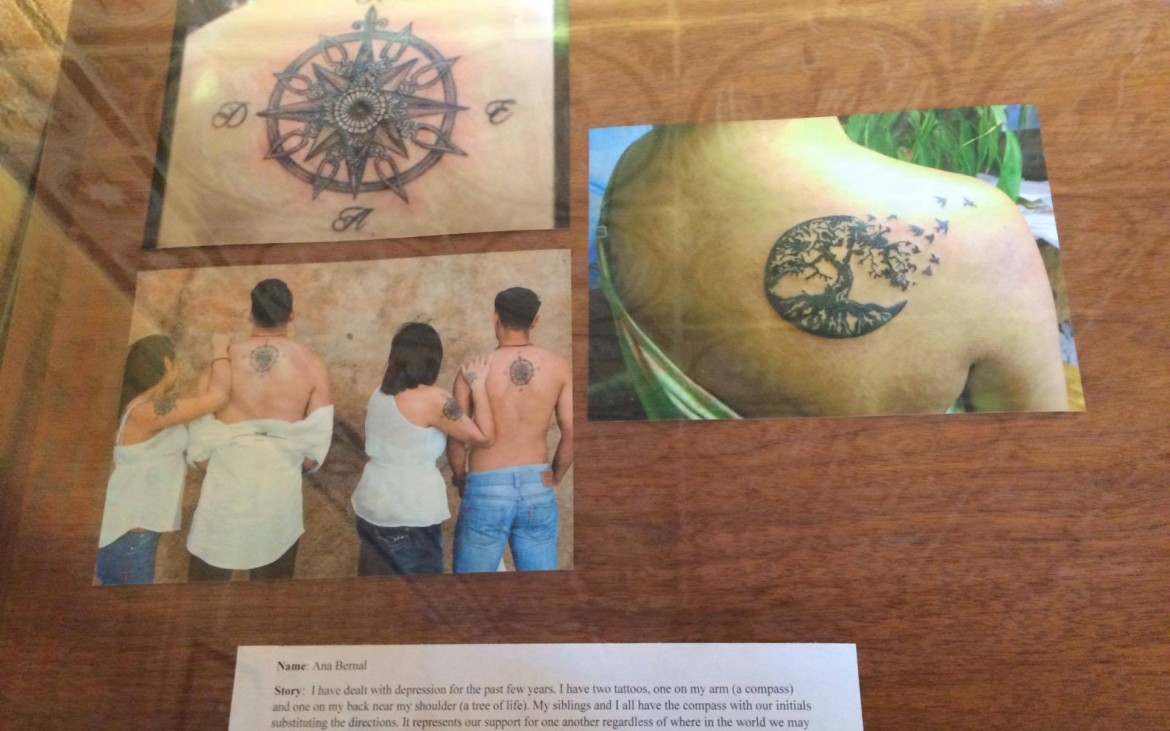Mental Health Tattoo Art Exhibition: Challenging Stigma and Perceptions of Mental Illness

Image: Angela Nguyen and Sarit Kashanian, photo courtesy of Nguyen.
*Note: Possible content warning for self-harm and suicide in this article.
On her right leg, Angela Nguyen has a tattoo of an orange and yellow awareness ribbon with butterfly wings.
Nguyen, a third-year student majoring in Psychology and minoring in Applied Developmental Psychology, chose orange and yellow because they’re the national colors for self-harm and suicide awareness, two issues that are personally relevant to her.
The butterfly wings represent the Butterfly Project, an online project for people who self-harm that encourages them to draw butterflies on their skin when they feel the urge to self-harm. It acts, Nguyen explained, as “a tangible representation of the life and care you should give yourself.” The ultimate goal is to reach a place where you no longer feel the urge to self-harm and do not need the butterflies anymore.
Nguyen got the tattoo after three consecutive months without self-harming. It sits on top of some of her scars and acts as a permanent butterfly. “This tattoo is to kind of commemorate that process of recovery, and also remind myself of where I’ve been and where I want to keep going,” she said.
This tattoo was the basis for “Mental Health Tattoo Art Exhibition,” which opened in the Powell Library Rotunda on Monday. The exhibition features photos of tattoos that are related to mental health or mental illness.
Nguyen organized this project for her “Art as Social and Political Commentary” class with Sarit Kashanian, a fourth-year student majoring in English. They hope that through this exhibition, people will feel more open about discussing mental illness and tattoos.

”We had to do an art exhibition about a social issue that we thought was really important,” Nguyen said. She decided to tackle two issues: the stigma around mental illness and tattoos.
The stigma around tattoos seems clear to Nguyen; people with tattoos are often called “trashy,” associated with being a criminal, or seen as unprofessional. But for her, tattoos are a form of art. And while it might be permanent, she believes that “people should have their own choice about their bodies.”
While the stigma around mental illness might appear less overt, Nguyen cites the flippant attitude towards mental illnesses as a sign of stigma. When people joke about tests and say, for instance, “That midterm was so hard, I’m just going to kill myself,” they act as if suicide is a joke and not a serious mental illness.
“There are so many students on campus who have dealt with mental health issues,” Nguyen said, “and [these jokes] can be really hurtful and invalidating, and put even more pressure to stay silent.”
The lack of serious discussion about mental illness is another sign of stigma, she says. Most of the people photographed for the exhibition submitted anonymously, she revealed, and did not feel like campus was a safe space for them to display their tattoos and mental health problems with their names attached.

“All of this misunderstanding is totally unwarranted,” Nguyen said. “These are real people [and] real stories. No one’s making anything up.”
With this exhibition, Nguyen aims to remind everyone that people with mental illnesses and people with tattoos are real, are human, and deserve to be treated decently. Beyond that, she hopes that people with mental illnesses can feel more safe on campus. She hopes, “If we get people talking about mental health, maybe down the line people will feel more open and can open up about their stories–and can seek help earlier.”
As for herself, Nguyen hopes to maintain the progress she’s made so far. “Recovery doesn’t really end,” she explained. “It’s on-going.” With her tattoo as a symbol of her own strength and her own personal butterfly, Nguyen hopes that she and others will always want to take care of themselves and maintain themselves, until they no longer need a butterfly.
The exhibition runs until March 3.




